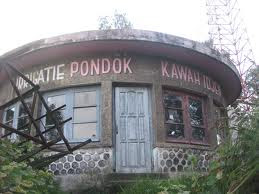Ijen Crater is the biggest crater lake in Java. The sulfur crater lake lies between a natural dams of deeply etched rock. It is 200 meters deep and contains about 36million cubic meters of steaming acid water, shrouded in a smelling swirling sulfur cloud. Inside the crater the different color and size of stones are found. Indeed the crater of Ijen is beautiful garden of stone as well.
The view of sulfur miners who climb and go down to the crater is also amazing. A man puts about 90 kg of yellowish sulfur stone in to his basket, before he descends the mountain slope to sell his load, carrying the same basket, going in the same direction, digging the same mineral. It is the natural picture that can be seen everyday.
The principal attraction at Ijen is the large Crater Lake that has much sulfur, which lies hidden between sheer walls of deeply furrowed rock at more than 200 meters. The Ijen crater itself lies at approximately 2,300 meters above sea level. It forms a twin volcano with the now extinct Mount Merapi. The enormous Crater Lake, which is 200 meters deep and covers an area of more than meters, a million square meters, contains about 36 million cubic meters of steaming, acid water.
Objects and Nature Travel Attractions in Ijen:
1.Paltuding (± 1850 m altitude)
It is the last post and the vehicle stops climbing preparation. Paltuding is also a limit of two districts, namely Banyuwangi and Bondowoso, where the limit is a path from the Dam Palttding crater. There are facilities and infrastructure for tourism, such as: camping, guesthouse, and canteen.
2.Pondok Bunder / Pondok Pengairan (± 2214 altitude)
Built during the reign of the Dutch East Indies, semicircular or in the Java language, so-called bottage called Bunder Bunder.
Its main function to measure rainfall per year. Moreover, because the air is cool with the natural landscape of the caldera Ijdn Giant Mountains (G. roar, Chain, Suket, flat, Plantation Kalisat, Belawan and Lijen) and bird watching area Bunder make this cottage as one of the preferred destinations of visitors.
Verbal information, the building was built in 1920 as a base camp staff that manages the irrigation dam Ijen. The last time water flowed into the river past the crater Dam in 1976, since it is slowly dwindling water and since 1979 the water reached the bottom of the crater is no longer Dam. In July of September will be able to see one of the charm of a bed of flowers "Edelwis". This area will be passed on the way to the crater lake and within ± 2 km of Postal Paltuding.
3. Ijen Crater Lake
Are ± 3 km from Paltuding and is one of the largest and most beautiful crater in the world in the form of an ellipse with a size of ± 960 x 600 m to the lake water levels ± 2140 m above sea level with a depth of 200 m has a volume of ± 36 million m³ of water and a lake with terasam water in the world with 0.5 ph. This lake can be reached by walking from time Paltuding ± 1.5 hours.
4.Sulfur Kitchen
In the kitchen there are some sulfur pipeline at any time remove sulfur. Prior to solid sulfur, sulfur has three stages, namely from the vapor to liquid (sublimation) and then becomes solid. Sulfur in liquid temperature ± 200 C. Sulfur jitchen is handled by its own officers ± 15 people charged with overseeing the pipe - the pipe is not clogged sulfur to solid sulfur, to prevent fire pipeline.
5.Sulfur Miners
A bearer can carry sulfur sulfur weighing 70-110 kg. This phenomenon is due to the attractions that amaze rough terrain while carrying heavy loads it with jail ± 3 k, 5 miles is something extraordinary. Usually they carry sulfur twice a day and sometimes they spend the night in the lodge or in paltuding. sulfur miners can be seen throughout the course of the crater to the lake Paltuding.
6. Damp (± 2145 m altitude)
Serves to keep the water in the crater of Ijen to avoid overflow. Dam was built in conjunction with the cabin Bunder. At the Dam water tunnel propagated 4 which serves to keep the water in the crater so as not to overflow and when the water level reaches the dam, the river flows to Banyuapit, so it does not harm the area below it.
To this building from the slopes of the crater. Approximately 100 meters there is a staircase with a number of steps 210 steps. The left is limited by a high stone wall with ± 50 meters.
7. Gypsum
Located 50 meters from the Dam. Gypsum in the crater formed by nature, so that this phenomenon many researchers invite for research in this area. Containing sulfuric acid is quite high and rising.
Calcium compounds in the crater into the water to react with aluminum ions and sulfate ions to form crystals that have a large - large and the filtrate direaksi with powdered limestone to form gypsum. So Ijen Crater water is one of the natural resources sulfatnya enormous potential.









waw....
BalasHapusperna ngrti aku....tinggal man ea yg belum kita kunjungi?
BalasHapus